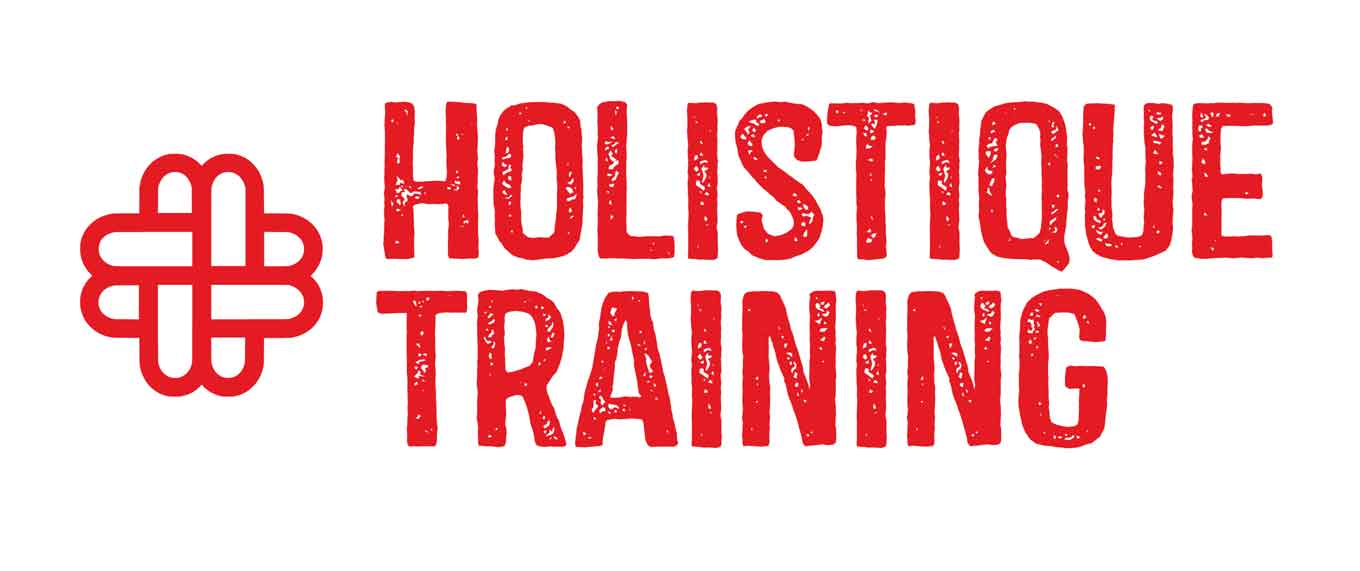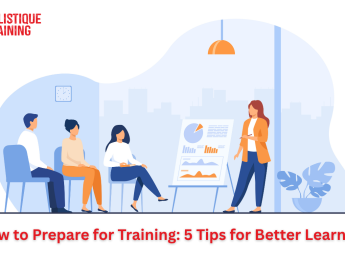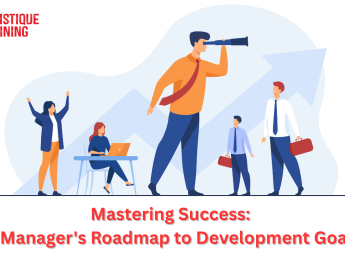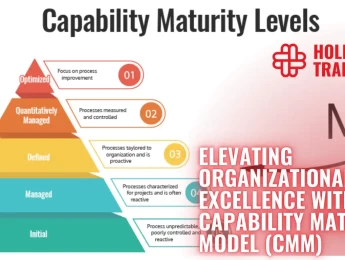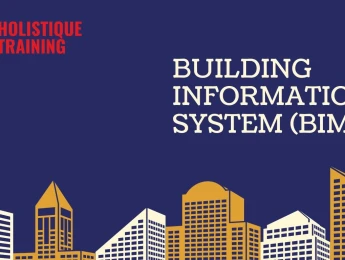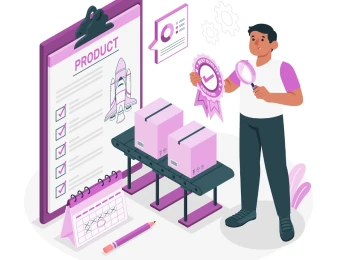- Table of Contents
- Introduction
- Why Preparation Matters Before Any Training
- 5 Tips to Make You Better Prepared to Learn
- 1. Clarify Your Learning Objectives
- 2. Engage in Pre-Training Preparation
- 3. Adopt an Active Learning Approach
- 4. Utilise Effective Note-Taking Strategies
- 5. Implement and Reflect Post-Training
- Common Mistakes People Make Before Training
- 1. Not Reviewing the Course Outline
- 2. Treating It as a Day Off
- 3. Coming Unprepared Technically or Logistically
- 4. Ignoring the Trainer's Background
- 5. Not Setting Personal Learning Goals
- How to Stay Focused During the Training
- 1. Turn Off Unnecessary Devices and Digital Distractions
- 2. Take Notes—But Do It Strategically
- 3. Take Short, Purposeful Breaks
- 4. Ask Questions and Contribute to Discussions
- Supporting Research
- After the Training: What Should You Do Next?
- 1. Review and Organise Your Notes Thoughtfully
- 2. Share What You’ve Learned with Others
- 3. Apply the Knowledge Practically and Immediately
- 4. Maintain the Network You Built
- Recommended Tools and Resources to Maximise Learning
- Conclusion
Introduction
In today’s professional landscape, training programmes have become more than just developmental opportunities; they are essential tools for career advancement, skill refinement, and adapting to rapidly changing work environments. Whether you are an early-career professional or an experienced leader, enrolling in a course or attending a workshop is a powerful step towards growth. However, the effectiveness of that training does not solely rely on the quality of the content or the reputation of the provider—it largely depends on you, the participant.
Far too often, individuals attend training sessions unprepared, expecting to absorb information passively, only to walk away with minimal value. But when you enter a training environment well-prepared, both mentally and practically, you set the foundation for deeper understanding, active engagement, and longer-term application of knowledge.
Preparation is the unsung hero of successful learning experiences. In this article, we will discuss the importance of preparing for training, common mistakes to avoid, practical ways to stay focused during the session, actionable steps to take afterwards, and recommended tools to maximise your learning journey.
Why Preparation Matters Before Any Training
Preparation is not about memorising the training material beforehand, but about setting yourself up to learn efficiently and effectively. Being prepared means arriving with clarity on your learning objectives, having the necessary tools at hand, and being in the right frame of mind to participate actively.
Mental preparation helps reduce performance anxiety and enhances your ability to focus and retain information. Physical preparation, like reviewing materials in advance or organising a quiet space for online training, ensures you are not distracted or caught off guard.
Let’s take a look at a quick comparison:
Aspect | Prepared Attendee | Unprepared Attendee |
Mental readiness | Clear goals, focused mindset | Passive mindset, uncertain purpose |
Time management | Structured plan, punctual | Rushes, misses key segments |
Engagement | Asks questions, takes notes, participates | Distracted, minimal interaction |
Retention of information | Higher due to active engagement | Lower due to passive listening |
Post-training application | Applies knowledge quickly and confidently | Forgets or avoids applying learnings |
Being prepared ultimately makes the training more enjoyable, relevant, and effective.
5 Tips to Make You Better Prepared to Learn
In today's fast-paced professional environment, attending training sessions is a vital component of continuous learning and career development. However, merely showing up isn't enough. To truly benefit from training, it's essential to prepare effectively. Proper preparation not only enhances comprehension but also facilitates the application of new knowledge in real-world scenarios. This article outlines five practical tips to help you maximize your learning experience during training sessions.
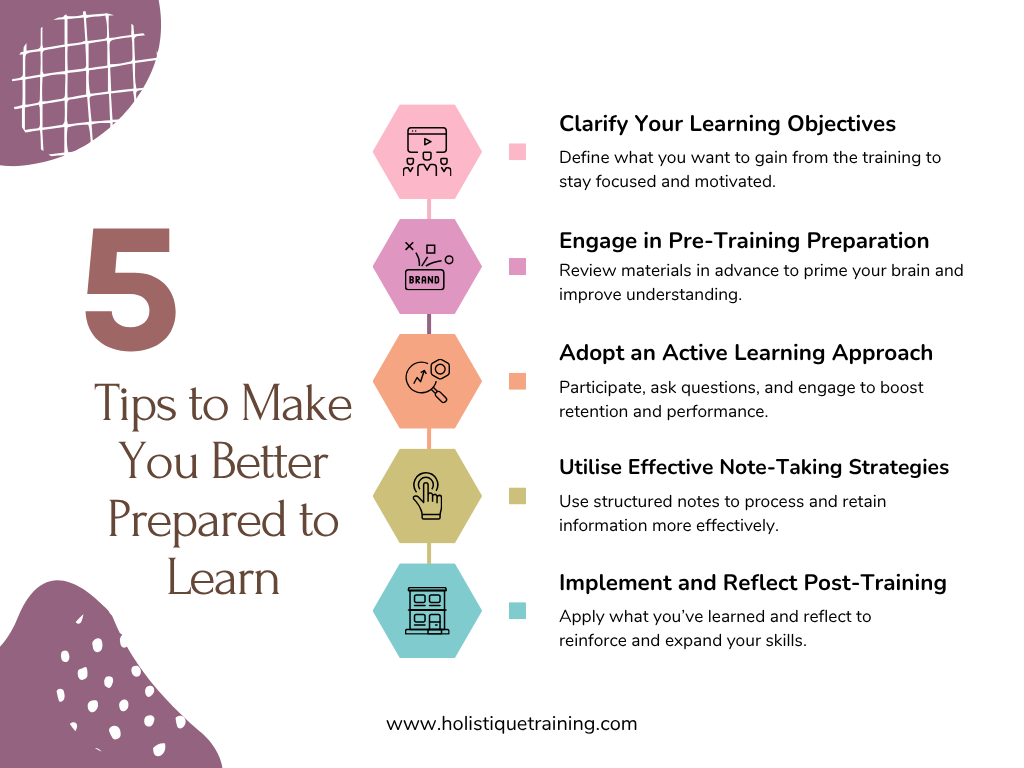
1. Clarify Your Learning Objectives
Before attending any training, take the time to identify what you aim to achieve. Are you looking to acquire a new skill, deepen your understanding of a particular topic, or solve a specific problem? Setting clear, measurable goals will provide direction and motivation throughout the training. Research indicates that students who engage in preparatory activities tailored to their learning objectives tend to absorb information more effectively.
2. Engage in Pre-Training Preparation
Familiarize yourself with the training material beforehand. This could involve reading relevant articles, watching instructional videos, or completing preliminary exercises. Such preparation primes your mind to receive new information and facilitates deeper understanding. A study published in the Journal of Cognitive Psychology found that students who engaged in preparatory activities before instruction demonstrated improved learning outcomes.
3. Adopt an Active Learning Approach
Active participation during training sessions—such as asking questions, engaging in discussions, and applying concepts through exercises—significantly enhances learning. Passive listening, on the other hand, often leads to lower retention rates. Research from the Proceedings of the National Academy of Sciences indicates that students in active learning environments outperform those in traditional lecture settings, with higher exam scores and lower failure rates.
4. Utilise Effective Note-Taking Strategies
Taking structured notes helps in organizing information and reinforces memory retention. Methods like the Cornell Note-Taking System or mind mapping can be particularly effective. These techniques encourage you to process information actively, making it easier to recall and apply later. Moreover, reviewing and summarizing your notes shortly after the training session can consolidate your learning.
5. Implement and Reflect Post-Training
After the training, apply what you've learned as soon as possible. This could involve practicing new skills, discussing concepts with colleagues, or integrating techniques into your workflow. Reflection is equally important—evaluate what you've learned, how you've applied it, and identify areas for further improvement. Such reflective practices not only reinforce learning but also promote continuous personal and professional development.
Common Mistakes People Make Before Training
1. Not Reviewing the Course Outline
Many attendees skip reviewing the course content in advance, assuming they’ll understand everything as it comes. This often leads to confusion during the session, especially if the training includes technical terms or builds on prior knowledge. Reviewing the agenda helps you identify which sections may require extra focus and prepares you to ask informed questions.
2. Treating It as a Day Off
Some individuals treat training days as a break from work rather than a valuable opportunity for growth. They arrive late, disengage, or multitask during the session. This mindset undermines the whole purpose of the training. If you view training as an investment in yourself, you are more likely to respect the time and effort involved—both yours and the trainer’s.
3. Coming Unprepared Technically or Logistically
For online training, failing to check your internet connection, log-in details, or software compatibility can cause unnecessary delays and stress. Similarly, arriving without a notebook, pen, or charger to an in-person event can leave you scrambling to keep up. A little logistical prep goes a long way.
4. Ignoring the Trainer's Background
Understanding who will be leading your training can provide context for their examples and style. Some trainers are academic, others industry-focused. Knowing their background can help you adjust your expectations and engagement style.
5. Not Setting Personal Learning Goals
Without clear personal objectives, it’s easy to drift through training without fully absorbing or applying what’s being taught. Setting goals like “I want to improve my presentation skills” or “I want to understand data visualisation basics” gives you direction and focus.
How to Stay Focused During the Training
Remaining focused during a training session is often easier said than done, particularly when the session spans several hours or even multiple days. Fatigue, distractions, and mental overload can all hinder your ability to absorb and retain new information. However, by approaching the experience with intentional strategies, you can dramatically enhance your ability to stay engaged and make the most of the opportunity. Below are four deeply effective methods—each rooted in cognitive research and practical insight—to help you remain attentive and mentally active throughout your training.
1. Turn Off Unnecessary Devices and Digital Distractions
One of the greatest enemies of concentration in the modern era is the digital device. Whether it's a smartphone buzzing with notifications, open social media tabs on your computer, or background apps pinging alerts—these constant interruptions fragment your focus and diminish your cognitive processing power.
Before the training session begins, take a few minutes to create a distraction-free environment. This includes:
- Switching your mobile phone to aeroplane mode or placing it physically out of reach.
- Closing any non-essential browser tabs or desktop applications.
- Logging out of messaging platforms like WhatsApp Web, Slack (unless relevant), or Teams.
- Using tools like Focus Assist on Windows or Do Not Disturb on Mac.
If the training is virtual, consider using full-screen mode to reduce the temptation of clicking away, and turn off email alerts or pop-up reminders that could pull your attention elsewhere.
Discipline in this area sets a psychological boundary that says, “This is learning time,” and helps you enter a more immersive mental state.
2. Take Notes—But Do It Strategically
Note-taking is not just for remembering facts; it's a cognitive process that reinforces learning. But how you take notes matters. Writing down every word the trainer says can become a passive activity that bypasses critical thinking. Instead, adopt active note-taking techniques such as:
- The Cornell Method: Divide your page into key points, details, and summary. This structure helps you categorise and reflect on what you've learned.
- Mind Mapping: Ideal for visual learners. Use diagrams to show relationships between ideas, which can aid memory retention.
- Bullet Journals: Clean, concise notes using symbols and short phrases for key insights or action items.
Summarising content in your own words forces your brain to interpret and rephrase concepts, which enhances understanding and long-term retention.
3. Take Short, Purposeful Breaks
Many people assume that staying focused means powering through without stopping. In reality, the brain needs periodic rest to process information and maintain energy levels. However, not all breaks are equal.
During scheduled pauses, aim to:
- Physically leave your desk or training space, if possible.
- Stretch your body to reduce tension and boost circulation.
- Drink water or grab a light, healthy snack.
- Avoid your phone, especially social media or messaging apps, which often overstimulate the brain and make it harder to return to a focused state.
A technique known as the Pomodoro Method—working in 25-minute bursts followed by 5-minute breaks—has been shown to improve productivity and concentration. If your training session doesn’t offer formal breaks, advocate for short mental pauses every 60–90 minutes, as this aligns with the brain’s natural attention span cycle.
4. Ask Questions and Contribute to Discussions
One of the most powerful ways to remain mentally engaged is by actively participating in the session. This includes asking questions, offering relevant experiences, or even just nodding and reacting visibly if the training is in person or via camera. Interaction creates cognitive ownership of the material, which significantly boosts retention.
Don’t be afraid to raise your hand or write in the chat if something is unclear or if you’d like to contribute an insight. Trainers appreciate engaged learners, and your question might help clarify things for others too.
Peer-to-peer engagement can also be powerful. If breakout rooms are available, join them enthusiastically. If the session is in person, initiate brief discussions with nearby attendees during group activities. This transforms learning from a solitary activity into a collaborative experience.
Supporting Research
A 2021 study published in the Journal of Educational Psychology revealed that learners who participated in active classroom strategies (such as interactive dialogue, group discussions, and real-time reflection) scored over 20% higher in knowledge retention and expressed greater satisfaction with the learning experience compared to those in passive learning environments.
Maintaining attention during training is not about having superhuman concentration. It’s about creating the right environment, using the right techniques, and choosing to be present. With a few simple adjustments—managing your devices, engaging your brain through strategic note-taking, giving yourself restorative breaks, and actively participating—you can transform even the longest session into a meaningful and memorable learning experience.
After the Training: What Should You Do Next?
Attending a training session is only one part of the learning equation. What you do after the session is often just as important—if not more so—than what you do during it. The post-training phase is where real transformation happens. This is the point at which passive knowledge must be turned into active practice, insights into action, and connections into ongoing collaboration.
Here’s a detailed breakdown of what you should be doing once the training session concludes, to ensure the investment of time and energy results in meaningful development.
1. Review and Organise Your Notes Thoughtfully
Within the first 24 hours after a training session, it’s crucial to revisit your notes while the content is still fresh in your mind. Don’t just read over them passively—engage actively with the material.
- Start by summarising each section in your own words. This not only reinforces understanding but also reveals whether you truly grasped the concepts.
- Highlight or underline key takeaways, tools, or frameworks mentioned during the training.
- If you noticed any areas where your understanding was unclear, flag them for follow-up reading or clarification.
- Consider creating a one-page summary or mind map to visually consolidate your understanding.
Organising your notes in a logical format—whether digitally via apps like Notion or Evernote, or in a dedicated notebook—makes it easier to return to the content in future projects or discussions.
2. Share What You’ve Learned with Others
One of the most effective ways to reinforce new knowledge is to teach it. When you explain what you’ve learned to someone else, your brain is forced to organise, interpret, and articulate information clearly—greatly enhancing retention.
Here’s how you can do it:
- Summarise your key learnings in a short presentation to your team or line manager.
- Write a short blog post or LinkedIn article sharing your insights and reflections. This not only helps you reflect but positions you as a continuous learner.
- Discuss specific concepts with a colleague in a similar role to explore how the ideas might be applied differently across functions.
According to learning theorist Edgar Dale’s "Cone of Experience," people retain up to 90% of what they teach others, compared to only 10% of what they read. So, sharing your knowledge isn’t just generous—it’s incredibly smart.
3. Apply the Knowledge Practically and Immediately
Knowledge that isn’t used tends to fade quickly. That’s why the most effective post-training strategy is immediate application. Even if the training was conceptual or theoretical in nature, there are almost always ways to implement new insights.
Here are a few practical ideas:
- If you learned a new communication framework, try using it in your next team meeting.
- If the training introduced a new tool or software, block time in your calendar to explore it hands-on.
- Create a small project or experiment that allows you to trial new skills in a safe, low-risk environment.
The key is to start small. Don’t wait for the “perfect” opportunity to apply what you’ve learned—take initiative and create opportunities for yourself. The more you use your new skills, the more confident and competent you’ll become.
4. Maintain the Network You Built
Training sessions are often attended by professionals across industries, departments, or geographic locations. These participants represent a valuable network of peers who share your interest in the subject matter.
To keep these connections alive:
- Send a follow-up email or message thanking the trainer and expressing how their insights were valuable to you.
- Add fellow attendees or the trainer on LinkedIn, and include a personal note referencing the session.
- Join any relevant post-training groups or forums if the provider offers them (e.g. WhatsApp, Slack, or online communities).
These contacts can lead to:
- Future collaboration opportunities
- Knowledge exchange and peer support
- Invitations to upcoming webinars, job opportunities, or further courses
And in some cases, staying in touch with a trainer can open the door to mentorship or one-on-one coaching, especially if the training was intensive or highly specialised.
Recommended Tools and Resources to Maximise Learning
To help extend your learning beyond the training day, consider using the following tools and platforms:
1. Coursera and FutureLearn
These platforms offer high-quality, university-led online courses across various subjects. Ideal for structured follow-up learning or deeper dives into topics introduced during training.
2. Notion and Evernote
Digital note-taking apps that allow you to organise training content, create task lists, and set reminders for follow-up learning.
3. TED Talks
Inspirational talks on a wide range of professional development topics. They can reinforce or expand on key ideas from your training.
4. Podcasts like HBR Ideacast or The Learning Leader Show
These offer ongoing insight from industry leaders, researchers, and educators. Easy to digest during commutes or breaks.
5. Google Keep or Microsoft OneNote
For visual thinkers, these apps allow for handwritten notes, drawings, and pinning important info that helps retain ideas longer.
Conclusion
Training sessions are not one-off events; they are pivotal moments in a continuous journey of personal and professional growth. Preparing thoroughly, avoiding common pitfalls, staying actively engaged, and taking steps after the training all contribute to making that journey more fruitful and fulfilling.
Think of training not just as time away from your regular duties, but as an investment in yourself—an opportunity to sharpen your skills, gain new perspectives, and build connections.
If you’re ready to take your learning journey seriously, explore our training catalogue at Holistique Training. We offer a range of transformative programmes designed to empower professionals like you. And don’t forget to sign up for our newsletter to receive fresh insights, course updates, and exclusive learning resources directly to your inbox.
